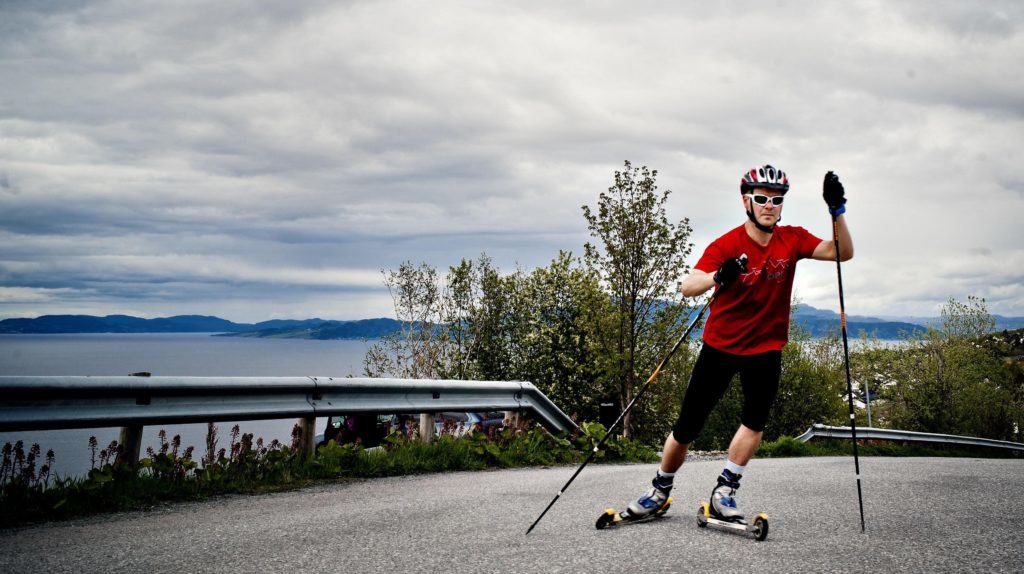
Hi, and welcome! So, maybe you clicked on this page because you are curious about trying roller skiing? The snow is gone in many parts of the world, and some poarts never see it. Roller skiing is a form of training that activates almost all the muscles in your body, gives you the opportunity for long work outs, and doesn´t produce a lot of injuries (unless you fall, but more about how to avoid that further down). So, maybe you should try? But wait a second! Before you suddenly find yourself in tricots and sunglasses, rolling about in 20 kh/h and forgot to think about how to stop before a pedestrian field or a truck, feel free to read forther for some practical advice.
At the bottom of the page you can read some of the roller ski producers own advice on the best roller skis for beginners.
What is necessary to know and to do before a successful roller ski training session? Where should you start practicing / training? There are a couple of important questions you need to find the answer to before you try to fit into the tricot for the first time (PS, regular shorts or other training clothing will probably work out fine too!):
Here you can read xc-marathon.com/turrenn.nets tips for safe roller skiing.
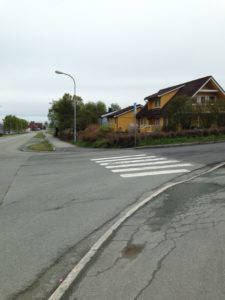
Where to start practicing?
In Norway the debate starts every year about roller skiers in regular traffic (including pavements and pedestrian-/bicycle areas). Serious accidents have unfortunately happened, and other users of the transportation grid can get annoyed by roller skiers taking place and slowing traffic. Well, OK, it might be demotivating starting to read this kind of article with such a message, but it should not.
All you need is this knowledge, practice and insght into how to go about in traffic. Both fysically/technically and in addition the ability to anticipate and analyse traffic.
All clear? Take for instance the image above. Everything looks clear and ready to go, doesn´t it? Not even a pedestrian in sight? Based on experience, I myself suddenly became aware of a typical «hidden trap» for roller skiers. See the image below (specifically point nr. 3). What I saw was a big hole, covering the whole width of the pavement I had planned to use (and 3-4 meters / 10-12 feet in length), leaving me with no space to roll on. Road workers had done this, and in Norway they are not expected to put up warning signs far ahead of an obstacle – just right in front of it… (yeah, I know!). The problem is that normally roller skiers have their attention only 5-10 meters (15-20 feet) ahead, looking for smaller holes, stones, and such that might interfer with the wheels, and tend to forget what might happen further down the road.
As a roller skier you have to know the whole route of you training session so that you are prepared for obstacles, and always able to stop / avoid them within the time and distance available. This does of course not mean that you should inspect the whole route in advance. But you should know the steep hills, the roundabouts, traffiic lights and tight turns – AND what lies the first 100-200 meters (300-500 feets) ahead of you. Here are (at least some images if you don´t fluently read norwegian) an example of what could happen if you don´t.
More tips for safe roller skiing here (same link as above).
Many «invisible» traps
Turrenn.net/xc-marathon.com thinks there also are other factors making the apparently clear road subject to a closer evaluation when roller skiing: 1) There might appear a car, bicycle, etc., from the road to the right fster than you expect. 2) A bus might «beat you to it» and stop and let off passengers at the pavement you have planned to use. And they are guaranteed to not pay attention to you! 3) As mentioned above; road- or pavement work can appear too late for you to stop or avoid it in a controlled manner, if you don´t look ahead all the time. 4) Further down the road there is a roundabout (road circle / rotary) with a crossover field for pedestrians (obviousle meaning that pedestrians might show up), and traffic might intersect you from four directions. And possibly the pavement you are using could end. Then you have to be prepared to hop onto the road – and control your speed so that you don´t collide with other traffic.
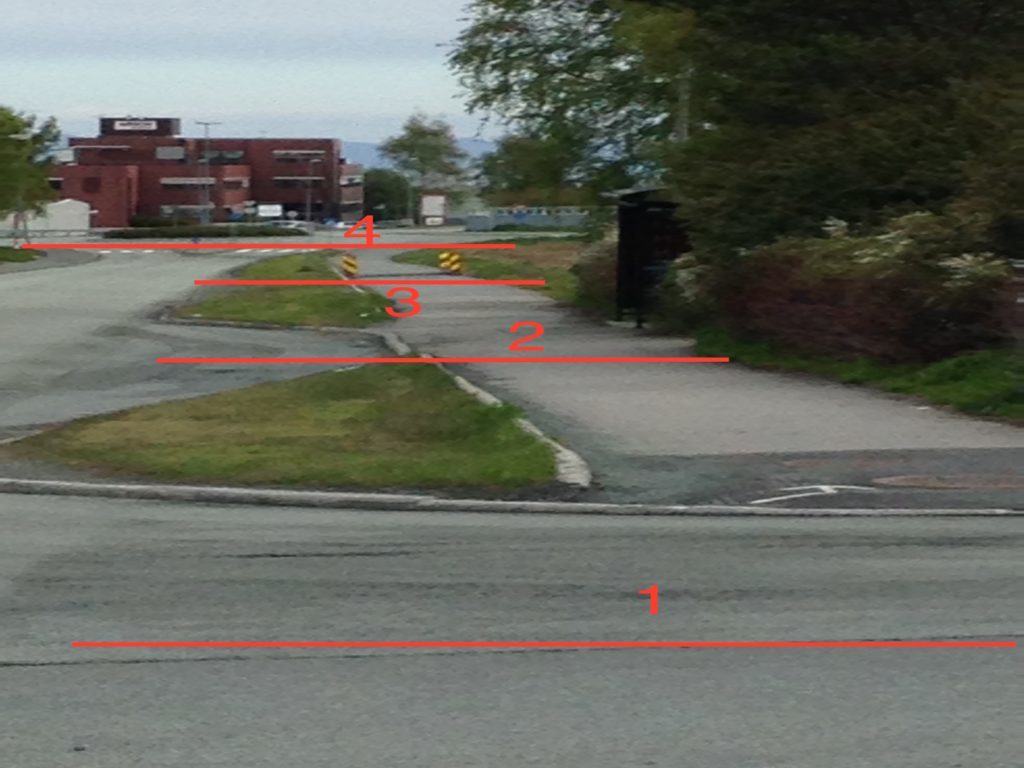
Practice first at a safe and closed area There are many ways to minimize the risk of mishappenings and accidents. The first, and best tip is to practice at a safe and closed area the first time(s) trying roller skis. A parking lot, for instance, is perfect. Practice changing directions, breaking, how to get up and doen from curbs, positioning the skis asymmetric in order to mainain balance (see image below) and how your poles can work as a breaking aid (stick them to the ground and push at the same time as you twist your arm wrists. The latter because the basket of the pole is shaped in such a way that you have to place it opposite as to how it is pointing when you are normally using it).
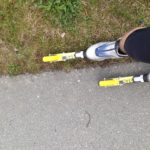
Breaking is the first question most people wonder about when deciding on whether or not to try roller skis. Can you break? Yes, you can, in different ways. Kan man bremse? Ja, det kan man, på flere måter. In this article you can find a video with proper breaking technique. But you can also do as the image to the left and below shows; look for grass, gravel, etc by the side of the pavement where you´re at and us it as a foundation for breaking. Obviously, you have to look out for this possiblity early, and not wait until you have picket up too much speed. You can use only one ski if the speed is modest, and shift pressure on and off the foot as the speed changes, or you might have to drive both skis onto the grass/gravel if the speed is higher. Note that the higher the speed, the greater the chance is for you to make an unplanned salto. But if it happens, it´s muvh better that it happens on soft ground than on asphalt!
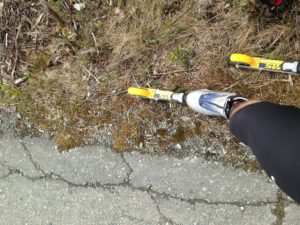
Roller ski tracks. In Scandinavia it´s quite easy to find especially designed tracks for roller skiing (usually cross country sites from winter) I unfortunately don´t know how the situation is regarding roller ski tracks in other parts of the world, but if you find one, remember that they often are made for trained athletes, and that the hills up and down might be qiute steep. A good tip might be to search for roller ski tracks on you tube or google. On youtube, obviously you can inspect many of the tracks as well.
PS! Feel free to inform other readers about tracks/spaces for roller skiing in the commentary field below!
Amateur competitons: Also, chek out your local area of there might be any amateur competitions. And again; feel free to inform other fellow readers in the commentary field below! Outside of Trondheim, Norway (my home town) for instance, the Mid-Norway roller ski cup is arranged for the second time.
STILL WITH ME!? PLEASE TAKE A WELL DESERVED BREAK AND LOOK AT SOME INSPIRING ROLLER SKI INSTAGRAMS:
[instagram-feed type=hashtag hashtag=»#rulleski, #rollerski» num=4 cols=2 showcaption=true]
Roller ski producers
Roller skiing must have had a positive development over the years, because today we see a lot of different producers and brands for roller skis. Also, there as a similar number of tests and recommendations online. As an alternative, in this article you can read the recommendations from the producers themselves below. Normally I don´t think that it is necessary to buy the most expensive nordic skiing equipment. But when it comes to roller skiing I think otherwise. Roller skis, asphalt, traffic and so on is a combination that requires trustworthy equipment both for security and a nice work-out experience. Bad equipment (skis) can both vibrate insanely at high speeds on poor asphalt (almost forcing you to pay a visit to your dentist afterwards putting your teeth back where they originally belonged…), and/or just break at the wrong place or time (…or speed – been there myself; the wheels just dissolved at about 50 mph). Still there should be no reason to expect that most roller skis and – equpment will give the somehow easy going amateur a safe and nice expereience.
Roller skis for all purposes. Also, in these days the selection of roller skis for different niches just grow bigger. For instance are the brand Skike making skis for gravel, with breaks, and the brands Rollersafe and Jenex are making roller skis for asphalt with breaks. IDT Sports have their own Classic Lady Pro ski, and Elpex have made a pure off road model.
The producers own recommendations for your first pair of roller skis:
START ROLLER SKIS
Recommendations given by Harri Aaltonen,
Export & racing management Startex Oy:
-For beginners or juniors we recommend the following skis:
Start Combi

- If one pair of roller skis are enough !
- Good rolling Combi ski, with speed of good snow winter conditions.
- Back rolling lock bearings for classic kick
- For skating and classic traning.
Start Classic Carbon

- New Start classic roller ski for classic training
- Medium speed, good training effect
- Good classic skiing abilities
· Stable
· well rolling - Comfortable and durable carbon composite frame
Start Skating 71

- Legendary Skating model with speed compared to good glide winter conditions
- Stable and durable frame and urethane wheels
- Good value for money
SWENOR ROLLER SKIS
Recommendations given by Jon Pedersen, Sport Import AS:
Classic:

-To beginners we recommend Swenor Fibreglass for most people. This is a steady ski. Because it is made of wooden laminates and glassfibre, it absorbs vibrations well. Therefor it is very good for double poling and poor asphalt.

-For small, light women we recommend Carbonfibre.

-For younger athletes we recommendSwenor Alutech Jr. This is a shorter ski and weights less. Smooth ski for 13 years old and younger.
Skating:

-For beginners we recommend Swenor Skate. The weight and length makes it easier to handle for a beginner.

-For young athletes we recommend Swenor Skate Junior. Very light and smooth ski for the youngest.
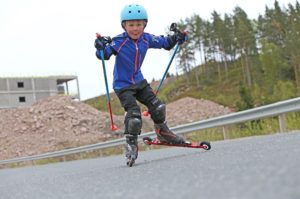
FISCHER ROLLER SKIS
Recommendations given by Alf-Roger Holme, Chief of marketing XC, Finor AS:
-Fischer have for a long time worked on developing roller skis. We are now introducing a completely new Carbonlite roller ski and we can now offer a complete line of roller skis for all kinds of skiers with competitive properties and long durability.
Regarding recommendations it depends somewhat on what the skier is looking for. Our RC 7 model is a little shorter for both classic and skating og will thus be easier to use and maneuvre for beginners. The Carbonlite roller skis will be more alike to the cross country feeling as they are slightly longer. The price is also a little lower for the RC 7 compared to our top model Carbonlite. Wheels and bearings are the same for both models, but Carbonlite are a little better on poor asphalt regarding vibration elimination because of the Carbonlite Air Core.
For juniors we have Junior Skate with short trunk for easy maneuvering and a lock on Junior Combi for classic kicking.
Fischer Carbonlite Classic
Carbonlite Classic. M01115 New AirCore Carbon trunk gives very good vibratino elimination and low weight. A little longer trunk increases stability and gives a better skiing feeling. Low profile wheels makes the skis maneuverable and precise. A lock on the back wheels gives the skis good grip. Max weight: 100 kg.
Wheel-to-wheel trunk length: 745 mm. Wheel size: 80 x 38 mm.
Weight: 1065 g.

Carbonlite Skate. M01015 New lowered vibration eliminating AirCore Carbon trunk with Razor Shape for low point of gravity gives the skis good stability. A little longer trunk increases stability and gives a better skiing feeling. Max weight: 100 kg.
Wheel-to-wheel trunk length: 630 mm. Wheel size: 100 x 24 mm.
Weight: 965 g.

RC 7 Classic. M02115 Broad die cast aluminum shaft with low point of gravity giving the skis high durability and stability. Low profile wheels make the skis maneuverable, stable and precise. A lock on the back wheels gives the skis good grip.The skis comes with a NIS-plate.
Wheel-to-wheel trunk length: 700 mm. Wheel size: 80 x 38 mm.
Weight: 990 g.

RC7 Skating. M02015 Die cast aluminum shaft gives the skis long durability and stability. Low profile wheels makes the skis maneuverable, stable and precise. The skis comes with NIS-plate.
Wheel-to-wheel trunk length: 620 mm. Wheel size: 100 x 24 mm.
Weight: 850 g.

Junior Skate. M03015 New skating ski for younger athletes. Broad wheels and low point of gravity. Die cast aluminum shaft gives durability and stability. Low profile wheels.
Wheel-to-wheel trunk length: 530 mm. Wheel size: 80 x 30 mm.
Weight: 730 g.

Junior Combi. M03115 New combi ski for the youngest athletes that can be used both for skating or classic. Same properties as Junior Skate. Back wheel lock for good grip.
Wheel-to-wheel trunk length: 500 mm. Wheel size: 80 x 38 mm.
Weight: 880 g.
IMPORTANT ABOUT FISCHER ROLLER SKIS:
Common for all models are low profile on the wheels and less rubber. This gives a highly maneuverable and precise ski. A great deal of our proffesional skiers have tested the skis with very good feed-back.
Finor 26.03.15 ARH



